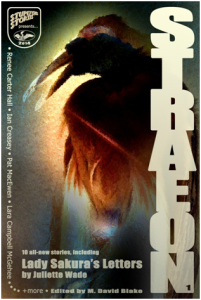 I’m excited to report that the first issue of the anthology, Straeon, edited by M. David Blake, has finally been released. It includes my novelette, “Rains of Craifa, Figure 1 – Girl with Shavlas”. (Just in case you’re wondering, a novelette is a long short story between 7,500 and 17,500 words. Another FYI — while the following discussion relates what inspired the story and discusses several facets of the theme, it doesn’t include any spoilers. ;))
I’m excited to report that the first issue of the anthology, Straeon, edited by M. David Blake, has finally been released. It includes my novelette, “Rains of Craifa, Figure 1 – Girl with Shavlas”. (Just in case you’re wondering, a novelette is a long short story between 7,500 and 17,500 words. Another FYI — while the following discussion relates what inspired the story and discusses several facets of the theme, it doesn’t include any spoilers. ;))
This is a story I wrote a number of years ago (like many of my writing projects), and it was originally entitled “Rainy Season”. The title was changed because — not surprisingly — that one has already been used numerous times. It’s also a positive change since I like how the new one adds a little extra to the story by providing a hint about what happens afterwards. Also, although some of my own titles are simple, I actually have a fondness for long, elaborate titles, both because they are so distinctive and because they may be quite poetic as well. (A couple of memorable examples I often think of are Delany’s “Time Considered as a Helix of Semi-Precious Stones” and “Stars in My Pocket Like Grains of Sand”; Harlan Ellison has also had quite a few very long and very unique titles that are pretty tough to forget.)
Naturally one of the advantages to pulling out a story after having not looked at it for some time is that it helps you view it objectively. (As I get older I seem to find it easier to do that even if the manuscript in question has only sat for a couple of months . . . I’m not sure if that’s a good thing or not! ;)) Being objective also helps make one more aware of things like symbolism. When my sister was studying Literary Criticism for her MA in English and showed me some of her assignments, I confess we laughed over how the serious critics often dissect a story in such depth that the resulting analysis seems absurdly elaborate (and sometimes rather far-fetched). The ‘lit crit’ folks would probably have a field day with this particular story, as there are many layers of symbolism and many ways in which all the elements tie together. Continue reading
